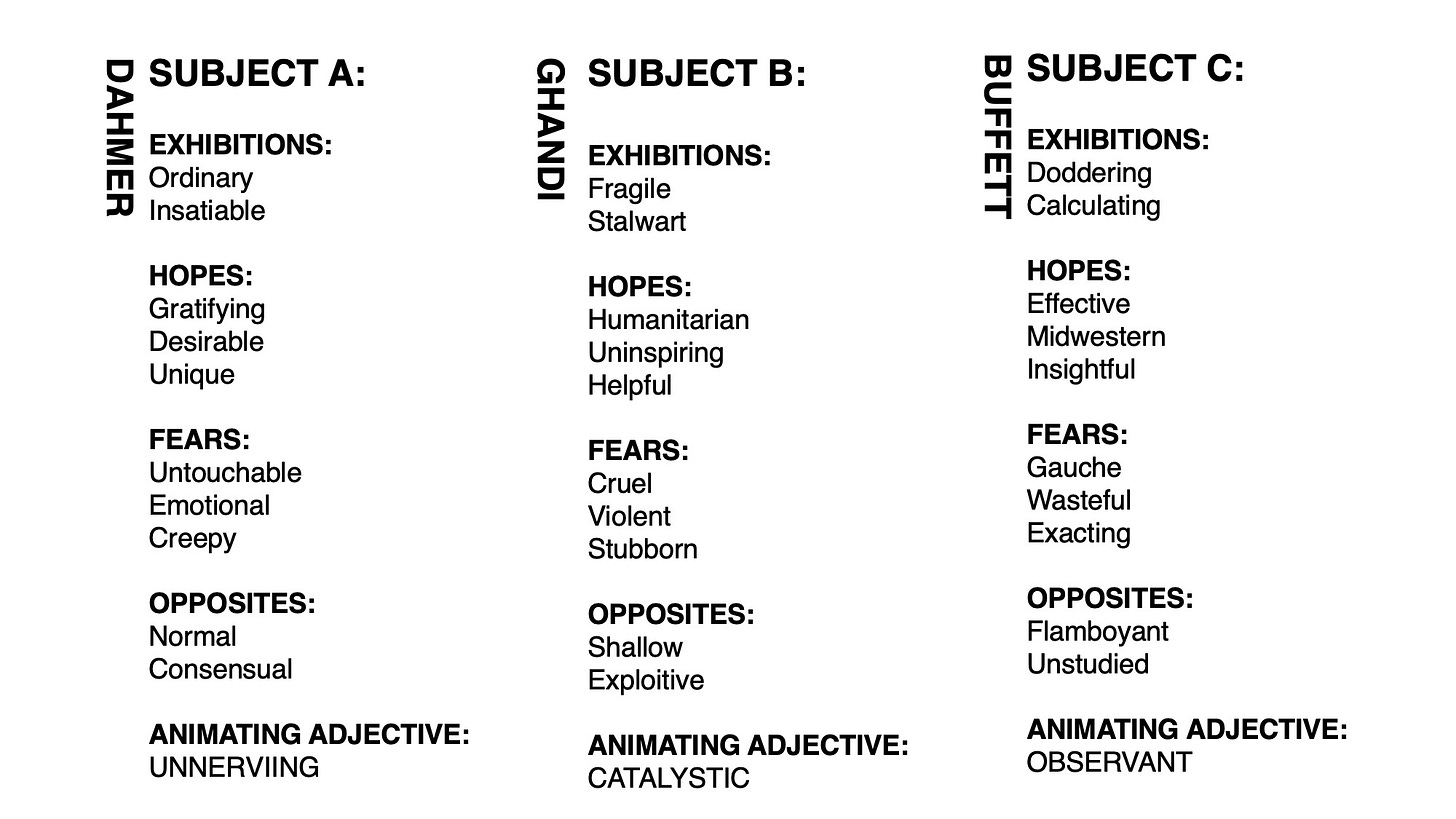An animating adjective is super-useful for putting together everything from dating app profiles to brand-guidelines, biographies, pitch-decks, legal defenses, and character studies for novels (pre-first draft).
An absolute keystone piece of any decent story is the animating adjective. It’s what defines motive and identity. It’s the detail that makes all the subject’s decisions make sense (at least in hindsight, hee hee). It’s the word the plot congeals around and the bends the arc of the project.
And it’s not all that tough to identify, if you can honestly fill in these 10 blanks with singular, precise, and heartfelt adjectives:
THE EXHIBITIONS:
(1)
Upon first impression, people assume that THE SUBJECT is _______.
This is the presence, style, cleanliness, sex appeal, physicality, and aura of the subject.
If the first impression adjective is negative, the story can be sculpted to satisfyingly upend the assumption. If the first impression adjective is positive, the story explains how the subject became so endearing.
(2)
When faced with adversity, THE SUBJECT continues to be ________.
This is the word that defines the subject outside of mere circumstance.
The core identity cannot be dissolved. This word is the spark that either dooms or redeems the protagonist, and the story becomes a case study in what or what not, to do.
THE HOPES:
(3)
THE SUBJECT places great value in doing _________ work.
This blank reveals motivation.
The more interesting the subject, the more unusual the motivation. The more interesting the subject, the less likely the completion of this sentence with be the word “rewarding.” This one takes a bit of thinking, and using a thesaurus is never cheating.
(4)
Despite it all, THE SUBJECT still feels ___________.
This is identity at work.
Whatever this word is: it reveals what the candidate for office, brand pitching the work, or human in front of you wants to prove to the world.
(5)
THE SUBJECT deeply respects that which is most __________.
Motivation is the why; this blank is the what.
This word and the word in point #3 should be obviously intertwined. This blanks points toward the goal in a redemption story and stands as a foregone conclusion to a glowing case study.
THE FEARS:
(6)
To be thought of as ___________ is THE SUBJECT’s worst nightmare.
This word is the emotional kryptonite of the story.
If this blank and any of the first three blanks are the same: the story is one of redemption. If this word is new, look for it be reflected in competitors or nemesis’ storylines.
(7)
THE SUBJECT is rendered impotent when presented with a _________ task.
This word reveals the subject’s Achille’s Heel.
Use this blank to answer the questions, “What is your greatest weakness?” and “What is your greatest pet peeve?” The more specific the word, the narrower the focus of the story will be.
(8)
THE SUBJECT was rejected for being too _________.
This word defines a fulcrum of identity.
Every company and character and thing is annoying in its own, special way. Those bugs can become features in the rightly framed context. To ignore the imperfect details means the entire story rings false: and acknowledging them is a starting point for better understanding.
THE OPPOSITES:
(9)
Nobody can accuse THE SUBJECT of being ________ with a straight face.
To offer both an insult and compliment in one line means only one will be chosen.
The word that erupts on this line is one that reveals a strength worth highlighting, or an insecurity that can be weaponized.
(10)
THE SUBJECT would rather dissolve into nothingness than ever conduct ________ business.
Here we have unearthed a taboo.
Red lines. Mortal sins. Soul-crushing concepts. This blank draws a line where a biography cannot go unless tragically coerced. Put this in context with the other adjectives, and a moral thesis is revealed.
Now, place all ten words together in their categories.
You can see a character, a story, take shape with just those words.
Ponder the arc of the words, and how they knit together to describe the subject you’re investigating. You’ll find words that are both large enough to tell an entire story without extremist tones, and concise enough to define your subject uniquely.
Do this a few times, with a few characters, and you’ll find both more awe and more sympathy for everybody, for every story.
It’s even something you can do as a party game. Then, if you dare, do it with yourself as the subject.
:)




